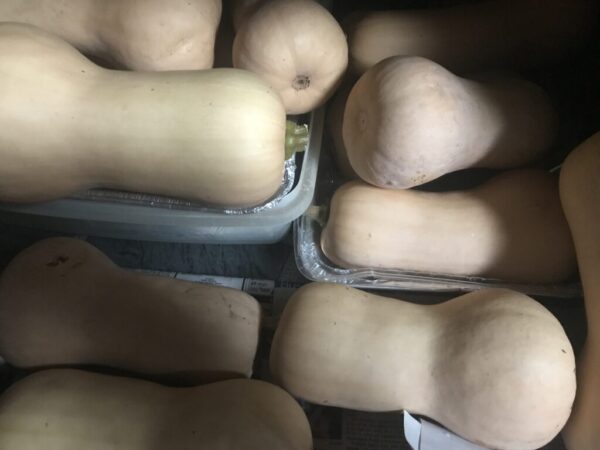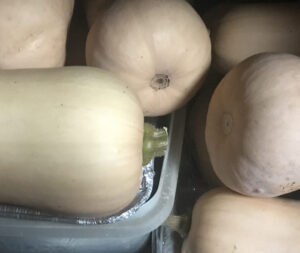- Like
- Digg
- Del
- Tumblr
- VKontakte
- Buffer
- Love This
- Odnoklassniki
- Meneame
- Blogger
- Amazon
- Yahoo Mail
- Gmail
- AOL
- Newsvine
- HackerNews
- Evernote
- MySpace
- Mail.ru
- Viadeo
- Line
- Comments
- Yummly
- SMS
- Viber
- Telegram
- Subscribe
- Skype
- Facebook Messenger
- Kakao
- LiveJournal
- Yammer
- Edgar
- Fintel
- Mix
- Instapaper
- Copy Link
A version of this column first ran in the Roane County (WV) Reporter and Times Record. Support local journalism! Subscribe to your local newspaper. This is one of a series of blogs for new gardeners. Read the rest: Part 1. Part 2. Part 3. Part 4. Part 5. Part 6. Part 7. Part 8.

Cucurbits are the vine crops: summer and winter squashes, pumpkins (which are winter squashes) and melons and cucumbers. All are tender plants which can’t be planted or set out until after the last spring frost, but I don’t bother starting them early inside. There’s no need in our climate; we have plenty of time to bring them to maturity planting them in May, or even June.
Incidentally, one vine crop not considered a cucurbit is sweet potatoes. If you succeeded in starting—or finding—some sweet potato slips, you can now set them outside if they’re big enough. Put them a foot apart or a little more, in rows two or three feet apart. They will eventually make a jungle of vines reaching several feet in all directions, so think about where they will least get in your way when deciding where to put them (if you put them near your garden entrance, you’ll have to step over the vines forty thousand times before you pull them just before it frosts). Someone said they spend the first month establishing roots (and may look rather sad meanwhile), then the second month growing out the vines, and get around to starting making the tubers in the third month. Once they get going with the vines you can forget weeding, and they don’t need much watering.
I only grow cucumbers every six years or so, for pickles, so I don’t have much advice on them. You can grow a dozen plants in a fairly small space, compared to other cucurbits. You might want to use row cover over them to keep the squash beetles off. These are ladybug- sized, yellow, striped or spotted bugs, which usually don’t do enough harm to worry about— except when they carry diseases like cucumber mosaic virus.
Melons we covered in the “Fruit in the Garden” column—their culture is pretty similar to squash. Both are usually grown in hills; put several seeds in a foot diameter space, thinned to the best two or three. For summer squashes a second hill could be two to three feet away but for watermelon or winter squash you need more like five feet. Sometimes their vines reach ten feet out, so as with the sweet potatoes, put them in an area where you won’t have to step over the vines every time you enter your garden. They want rich soil and full sun. Rumor has it that nasturtiums or radishes protect against bugs…I don’t know if there’s anything to it, but I put a few nasturtiums among the squashes and thus have flowers for my bouquets.
I have seen a claim that a summer squash named Lemon resists bugs better than others. It has seemed true so I keep planting it. The ripe fruits look like lemons. On winter squash, borers can be a problem, especially in wet ground, but they don’t bother the ones in the moschata species. This includes butternuts. I’m always trying new squashes and have yet to find one any better than butternuts (as witnessed by the bounty of the fall harvest captured in the photograph above). The species that includes cushaws also resists borers—the only problem there is trying to use up one of those galumphing fruits before it spoils! Squashes referred to as “pumpkins” actually come from a number of different species.
Perhaps the biggest problem with squash is the squash bug. Adults are blackish or dark grey and close to an inch long, and leave clusters of small orange eggs on the leaves, usually the underside. These hatch into delicate whitish nymphs scurrying around on a leaf. Best control is to check the leaves every other day and pluck out any egg masses, to burn or dispose of, and mash all the nymphs and adults. At the end of the season, if you had any of these, get rid of the mulch as it will otherwise harbor them, carrying them over the winter. Then next year’s squash won’t have a chance, attacked by ravenous hordes while in its babyhood. I learned this the hard way.
A common problem with summer squash is overabundance. One year I and some other young people (yes, this was centuries ago) grew a big garden using seeds someone had given us. After everything was established, a nerdy type calculated yields and said, “Wow…22 hills of zucchini will yield half a ton!” It did, and before it was over, two of us had nightmares featuring zucchini.
Some years the winter squash and melons don’t make it to maturity before frost, especially if you planted them late. I pull my garlic and onions at the end of June, and then if I follow them with melons or squash it may be pushing the season. So when I plant a bed with onions or garlic, I sometimes leave a couple of bare patches in the middle to put squash or melon hills in. By the time the plants need more room, the garlic or onions are coming out. Then the cucurbits get the whole bed to themselves. Along with the surrounding aisles and maybe the surrounding beds… polite and restrained, they are not.













